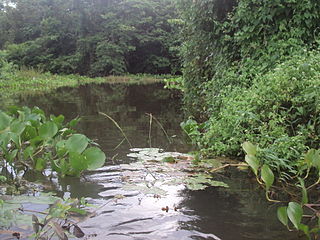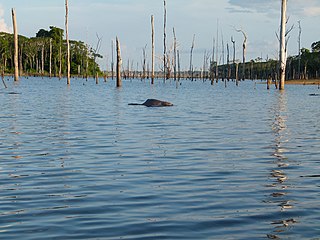Location
The Cabo Orange National Park has an area of 657,318 hectares (1,624,270 acres). It covers parts of the municipalities of Calçoene and Oiapoque. To the southwest the park adjoins the 2,369,400 hectares (5,855,000 acres) Amapá State Forest, a sustainable use conservation unit established in 2006.
The Park is significant because it is situated on the coastline of Brazil; the only one in the rainforest that enjoys such a location. This means that the faunal and floral species found here are quite different from those of the areas situated further inland. The park is accessible by boat and provides a fascinating look at the very different ecosystems of the coast and the jungle, juxtaposed with one another. The Cabo Orange National Park covers varied ecosystems, examples of which are mangroves, natural fields, fluvial marine forests, floodable areas, and terra firm, besides rich fauna.
The natural beauties, rather well preserved and with evident tourist appeal – the case of the Cassiporé, Cunani, Uaçá, and Oiapoque – allow for boat, canoe, and launch trips and the practice of rafting. The vast biodiversity makes possible visitation for contemplating vegetal and animal species, above all birds, in addition to projects of environmental education and scientific research (main objectives of the national parks).
Conservation
The park is classified as IUCN protected-area category II (national park). The basic objective is the preservation of natural ecosystems of great ecological relevance and scenic beauty. This enables the conduct of scientific research, the development of educational activities and environmental interpretation, recreation in contact with nature and eco-tourism. It is part of the Amapá Biodiversity Corridor, created in 2003. The park is supported by the Amazon Region Protected Areas Program.
Protected species in the park include the giant armadillo (Priodontes maximus), giant anteater (Myrmecophaga tridactyla), jaguar (Panthera onca), oncilla (Leopardus tigrinus), black bearded saki (Chiropotes satanas), green sea turtle (Chelonia mydas), smalltooth sawfish (Pristis pectinata), West Indian manatee (Trichechus manatus) and Amazonian manatee (Trichechus inunguis).

The Tumucumaque Mountains National Park is situated in the Amazon Rainforest in the Brazilian states of Amapá and Pará. It is bordered to the north by French Guiana and Suriname.

The Jaú National Park is a national park located in the state of Amazonas, Brazil. It is one of the largest forest reserves in South America, and part of a World Heritage Site.

Fernando de Noronha Marine National Park is a national park in the state of Pernambuco, Brazil.

The Pantanal Matogrossense National Park is a national park in the state of Mato Grosso at the border to Mato Grosso do Sul, Brazil.

The Serra do Pardo National Park is a National park in the state of Pará, Brazil.

The Catimbau National Park is a national park in the state of Pernambuco, Brazil. It protects a semi-arid area of caatinga with sandstone caverns and caves in which prehistoric art has been found.

Viruá National Park is a national park in the state of Roraima, Brazil. It protects an area with very infertile sandy soil, periodically flooded, that has no economic value but has exceptionally high biodiversity.

Lago Piratuba Biological Reserve is a biological reserve in the state of Amapá, Brazil.

Uatumã Biological Reserve is a Biological reserve around the river Uatumã in the state of Amazonas in Brazil.

Anavilhanas National Park is a national park that encompasses a huge river archipelago in the Rio Negro in the state of Amazonas, Brazil. It is part of a World Heritage Site.
Maracá-Jipioca Ecological Station is an ecological station covering two islands about 5 kilometres (3.1 mi) offshore from Amapá, a municipality in Amapá state, Brazil. It protects an area of coastal mangroves and tropical rainforest.

Jari Ecological Station is an ecological station in Brazil, located in the states of Amapá and Pará, created in 1984.

Rio Novo National Park is a national park in the state of Pará, Brazil.
Nascentes do Lago Jari National Park is a national park in the state of Amazonas, Brazil. It protects an area of Amazon rainforest in the BR-319 highway area of influence.

The Campos Amazônicos National Park is a National park in the states of Rondônia, Amazonas and Mato Grosso, Brazil.

The Descobrimento National Park is a national park in the state of Bahia, Brazil.
The Aripuanã National Forest is a national forest in the state of Amazonas, Brazil. It supports sustainable forestry, and also protects the environment, supports scientific research and protects the sustainable lifestyle of the traditional inhabitants of the forest.

The Médio Juruá Extractive Reserve is an extractive reserve in the state of Amazonas Brazil.

The Amapá National Forest is a national forest in the state of Amapá, Brazil. It supports sustainable exploitation of the natural resources in an area of Amazon rainforest in the Guiana Shield.

The Rio Cajari Extractive Reserve is an extractive reserve in the state of Amapá, Brazil. It protects a region of dense rainforest, cerrado fields and flooded riparian zones that is rich in biodiversity. Formerly it was used for rubber extraction, and later efforts were made to develop a pulp industry. Extraction of timber for sale is now prohibited. The residents, who are poorly educated and suffer poor health, engage in subsistence hunting, fishing and farming, and extract forest products such as Brazil nuts, açaí palm fruit and heart of palm.
This page is based on this
Wikipedia article Text is available under the
CC BY-SA 4.0 license; additional terms may apply.
Images, videos and audio are available under their respective licenses.


















